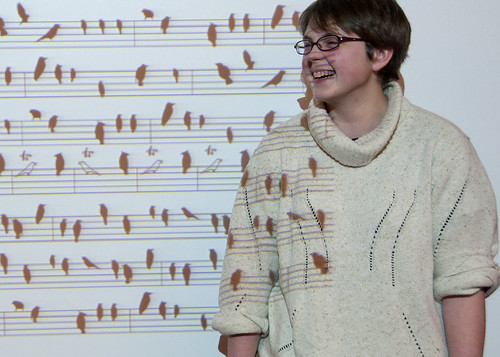
The winner of the “Birds Eye View” contest was named last week.
The grand prize winner of a student art contest was revealed last week at the Graphic and Interactive Design at Tyler School of Art’s launching of the “Bird’s Eye View” initiative.
The initiative features an exhibit highlighting submitted entries of student artwork designed to combat the perpetual collisions of birds into clear glass windows.
In Philadelphia, there are more than 100,000 annual bird deaths-by-collision. They are caused by birds slamming into transparent or reflective glass that they perceive as a continuation of open sky or a tangible natural landmark, like a tree.
“We’re trying to use education and also some research on birds here in Philadelphia,” said Keith Russell of Audubon Pennsylvania, an environmental research center that examined the causes of bird window collisions in Philadelphia for the past three years.
“Now we’re working on finding solutions. Temple has been a tremendous part in that,” he added.
Both Temple and a small quadrant of Center City were selected as primary target areas of research in 2009, an expansion from its original testing site of only a few blocks of downtown terrain.
Research gathered by the environmentalist group has scaled the number of collision based deaths on Main Campus at around 1,200 per year, mostly in Paley Library, the Student Center and Tyler School of Art.
The exhibit’s goal is to shrink the lump sum of deaths by creating a new commodity in glass film covers that bare intricate design patterns able to ward off oncoming traffic.
Sophomore art major Molly Denisevincz took home the grand prize, out of four other finalists, incorporating multiple senses perceptible to birds, including sight and sound, making them aware that they’re approaching something tangible and potentially fatal if hit with a full head of steam.
“I looked for where birds were safe in cities, and I found that they were most often found on power lines,” Denisevicz said. “From there I applied the concept to music in a piece called ‘The Cardinal.’”
Her film cover includes rows of black lines fitted with black silhouettes of various bird species arranged in a way to mimic the actual bars and notes of the aforementioned piece, or, in other words, sheet music with birds replacing traditional note symbols.
A general rule is that for whatever type a design is made, figures on the design have to be less than an inch apart, or else a bird in mid-flight won’t be able to detect and recognize the spacing as a solid object.
Film covers for glass seems to be a practical way to deter birds from flying into windows, Russell said. In his presentation, Russell noted how various forms of films have been tried and tested during the years, with probably the most common form coming in the film cover public transportation buses place over their seating and door windows, as well as in various store windows.
Russell said he sees the winning film project being the launching pad for a new commodity that he hopes can be affordable and accessible to the average resident, potentially saving thousands of birds.
“Work in the exhibition has the potential to be put to practical use on window films that would actually be produced, installed and monitored for effectiveness,” said Graphic and Interactive Design professor Alice Drueding.
“The exhibition is a spark that will hopefully catch fire,” Drueding said.
Drueding, who was on the panel of judges to determine the contest winner, said she believes that simple awareness and education will catapult this issue into the forefront of Main Campus consciousness.
“Awareness spreads from the faculty and students who participated in the project to their family and friends, to people who learn about it through seeing the exhibition and those who learn about it through media coverage,” Drueding said. “Widespread knowledge of the problem is the first step in solving it.”
Khoury Johnson can be reached at khoury.johnson@temple.edu.


Be the first to comment